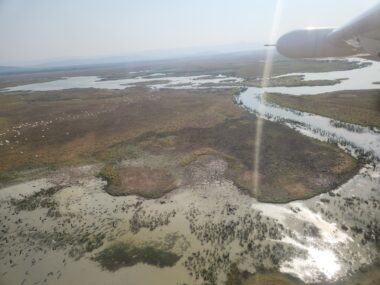UNSW researchers have developed a new low-energy technique to recycle plastic, which could be coming to a Tim Tam package near you.
The process can transform many forms of waste plastic into their respective polymer nanoparticles dispersed in water which can then either be extracted for re-use in preparing new consumer products, or utilised still in the aqueous dispersion in applications such as asphalting and waterproof coatings.
The innovative technique also removes dyes from the original plastic waste, which currently requires separate treatment, thus reducing the time and cost of recycling and expanding the waste source.
Team leads Professor Per Zetterlund and Dr Vipul Agarwal, from the School of Chemical Engineering, are working in collaboration with ‘impact investment’ firm FP Paradigm to further develop and commercialize the technology specifically pertaining to PET (polyethylene terephthalate) recycling. The relevant aspects of the UNSW patent (PET in food and beverage applications) have been licenced to FP Paradigm.
Paco Industries, the R&D subcontractor for FP Paradigm, have recently announced a deal with the Arnott’s Group – makers of Tim Tams and Shapes – to explore the use of this new technology as a more sustainable PET alternative across their range of products.
The UNSW researchers say their new method – which can be used on a wide range of common materials such as bags, bottles made from polyethylene, polypropylene, polystyrene, and PET – has the potential to significantly reduce the degradation of the plastic (polymers) during recycling.
Arnott’s are particularly keen on the fact that the process can isolate PET from other types of waste plastics and has the potential to turn contaminated PET waste back into food-grade PET for the food and beverage industry.
Non-degradation
“Plastics recycling is a massive challenge globally and there are many hurdles to overcome. For example, CSIRO statistics show that 84 per cent of plastic currently used in Australia is sent to landfill and only 13 per cent is recycled,” said Dr Agarwal.
“One of the main issues with the current way of recycling plastics is that it typically requires very high temperatures and therefore considerable amounts of energy and, in many cases, high shear forces during melt extrusion,” said Prof. Zetterlund.
“This can lead to the breakdown of individual polymer chains in the plastic, which is one of the reasons why you cannot recycle an infinite number of times, because each time the process is done the polymer degrades.
“Our method has the potential of causing no mechanical or chemical degradation of the polymer, so we believe it may be possible to recycle the plastic a higher number of times than using existing recycling processes.
“In addition, there is no need for extensive cleaning of the waste plastic before it is recycled. This process also has the potential to separate the polymer from various additives such as dyes, eliminating one of the stages currently required in current recycling processes.”
“The other advantages of this new technology are tolerance to mixed plastic waste allowing segregation of different waste plastics during the recycling process, and recycling of chemicals used in the process,” said Dr Agarwal.
In addition to the deal with Arnott’s, Paco have also facilitated an agreement with Sydney-based sustainably-focused coffee company Pablo & Rusty’s to assist with the commercialisation of the UNSW-developed recycled PET.
Arnott’s Group Chief Transformation Officer Simon Lowden said: “This agreement reflects our commitment as a business to go beyond our sustainable commitments and find new technologies – so that the Arnott’s Group can continue to create delicious moments, not just for our consumers, but for our value chain and planet as well.”
According to the CSIRO, Australians used 3.5 million tonnes of plastics in 2018 to 2019, with around 130,000 tonnes leaking into marine environments each year.
By 2050, they estimate that plastic in the oceans will outweigh fish.
CSIRO have calculated that Australia is missing out on an estimated $419m of economic value each year by not recovering all PET and HDPE (high-density polyethylene) materials.
PET is one of the world's most commonly used plastics with approximately 10 per cent of all plastics being made from PET, with around a third of that used in global food and beverage packaging.
The primary challenge is the level of contamination in such plastic, making it harder to recycle without being thoroughly cleaned.
Aqueous dispersion
Prof. Zetterlund and Dr Agarwal’s patent covers the specific process which converts waste plastic into an aqueous dispersion of plastic polymer nanoparticles, allowing the very small solid polymer particles to be uniformly distributed in a water-based solution.
The obtained dispersed nanoparticles are not to be confused with microplastics.
In their patented method, different types of waste polymers can be segregated potentially enabling simultaneous recycling of different types of plastics.
At the next stage, a traditional filtration process can extract the nanoparticles to then produce pellets or powder which can be used to make new plastic materials.
But the UNSW research team, which also includes postdoctoral fellow Dr Mike Dinh and previously Dr Rabiatul Adawiah Mat Noor, say the aqueous solution with the particles remaining dispersed can provide benefits in various other applications, such as the production of asphalt as one example.
Recycled plastic is currently used in asphalt via a melting process whereby it becomes part of the bituminous binder that ‘glues’ together the sand and gravel aggregate.
“Using our process, we can take the aqueous waste plastic dispersion and instead coat the aggregate material before it’s added to make the asphalt, and that can help everything to bind really well. We believe it will improve the strength and durability of the final asphalt,” said Dr Agarwal.
“We also believe that our recycled aqueous waste plastic dispersion has potential use in the production of waterproofing materials, high strength concrete following the same principle as asphalt, paints and insulation coatings.”
****
Group photo pictured from left-to-right: Steven Commerford (Head of Commercial, Paco Industries), Quang Ly (Industry & Innovation Manager UNSW), Dr Vipul Agarwal (UNSW), Professor Per Zetterlund (UNSW), Professor Julien Epps (Dean of Engineering, UNSW), Abdullah Ramay (CEO, Pablo & Rusty’s Coffee), Alberto Peixeiro (R&D Director, Packaging Development ANZ at The Arnott's Group), Hamish Manton (Project Manager, FP Paradigm).
Key Facts:
Arnott’s Group, makers of the iconic Tim Tam, signs deal to explore ways to utilise patented research from UNSW to convert solid waste plastic at low energy and without extensive cleaning.
Contact details:
For enquiries about this story and for interview requests please contact Cecilia Duong, News & Content Coordinator
Email: [email protected]


